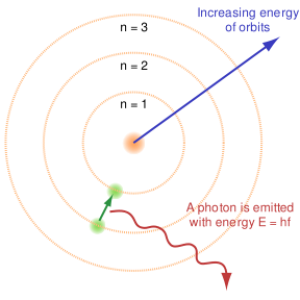College of Liberal Arts & Sciences
7B50.15 - Bohr Atom
Pick the appropriate computer simulation for your presentation.
A laser etched crystal is available which has some Bohr atom orbital representations such as those shown in the Grand Orbitals Table on the website listed below.
- Kenneth W. Ford, "Niels Bohr's First 1913 Paper: Still Relevant, Still Exciting, Still Puzzling", TPT, Vol. 56, #8, Nov. 2018, p. 500.
- Ken Ford, "Teaching the Bohr Atom", TPT, Vol. 56, #4, Apr. 2018, p. 196.
- Stefano Oss and Tommaso Rosi, "A Bit of Quantum Mechanics", TPT, Vol. 53, #4, Apr 2015, p. 230.
- Mark B. Schneider, "Quantum Mechanics for Beginning Physics Students", TPT, Vol. 48, #7, Oct. 2010, p. 484.
- Jay M. Pasachoff, "The Bohr Staircase", TPT, Vol. 42, #1, Jan. 2004, p. 38.
- Joseph Y. Pollock, "Fiscal Atomic-Levels Demonstration", TPT, Vol. 42, #1, Jan. 2004, p. 50.
- David Thompson, "Three Everyday Examples of Quantization", TPT, Vol. 36, #2, Feb. 1998, p. 92.
- "Energy in Bohr Orbits", TPT, Vol. 23, #5, May 1985, p. 305.
- Jay M. Pasachoff, "Haystack Radio Telescope", AJP, Vol. 70, #10, Oct. 2002, p. 983.
- Gordon McIntosh. "A Modern Physics Laboratory Activity: Radio Astronomical Observations of Recombination Lines", AJP, Vol. 70, #3, Mar. 2002, p. 285.
- Dmitry Budker, "Electrons in a Shell", AJP, Vol. 66, #7, July 1998, p. 572.
- Frank R. Tangherlini, "Schrödinger’s Radial Equation", Physics Today, Vol. 68, #3, Mar. 2015, p. 8.
- Anatoly Svidzinsky, Marlan Scully, and Dudley Herschbach, "Bohr's Molecular Model and the Melding of Classical and Quantum Mechanics", Physics Today, Vol. 67, #8, Aug. 2014, p. 10.
- Petar Grujic, "Bohr's Molecular Model and the Melding of Classical and Quantum Mechanics", Physics Today, Vol. 67, #8, Aug. 2014, p. 8.
- Leonard Mlodinow, "Bohr's Molecular Model and the Melding of Classical and Quantum Mechanics", Physics Today, Vol. 67, #8, Aug. 2014, p. 8.
- M. Y. Amusia, "Bohr's Molecular Model and the Melding of Classical and Quantum Mechanics", Physics Today, Vol. 67, #8, Aug. 2014, p. 8.
- Anatoly Svidzinsky, Marlan Scully, and Dudley Herschbach, "Bohr's Molecular Model, a Century Later", Physics Today, Vol. 67, #1, Jan. 2014, p. 33.
- "S-105. Banding Mat'l-Corrugated Roof", DICK and RAE Physics Demo Notebook, 1993.
- David Kutliroff, "56. How Empty Is Space in the Microcosm?", 101 Classroom Demonstrations and Experiments For Teaching Physics, p. 125 - 126.
- John G. Cramer, "Watching the Quantum Jump", Analog and Science Fiction/Science Fact Magazine, p. 137 - 141.
- T. D. Rossing and C. J. Chiaverina, "6.5. Atoms", Light Science, Physics and Visual Arts, p. 134 - 136.
- Bobby Mercer, "Candy Atoms", Junk Drawer Chemistry, 2016, p. 57 - 63.
- Robert Ehrlich, "J.10. Rubbing the Edge of a Wine Glass", Turning the World Inside Out and 174 Other Simple Physics Demonstrations, p. 135 - 136.
- Sara Stein, "Atomic Poetry", The Science Book, p. 210.
Disclaimer: These demonstrations are provided only for illustrative use by persons affiliated with The University of Iowa and only under the direction of a trained instructor or physicist. The University of Iowa is not responsible for demonstrations performed by those using their own equipment or who choose to use this reference material for their own purpose. The demonstrations included here are within the public domain and can be found in materials contained in libraries, bookstores, and through electronic sources. Performing all or any portion of any of these demonstrations, with or without revisions not depicted here entails inherent risks. These risks include, without limitation, bodily injury (and possibly death), including risks to health that may be temporary or permanent and that may exacerbate a pre-existing medical condition; and property loss or damage. Anyone performing any part of these demonstrations, even with revisions, knowingly and voluntarily assumes all risks associated with them.
